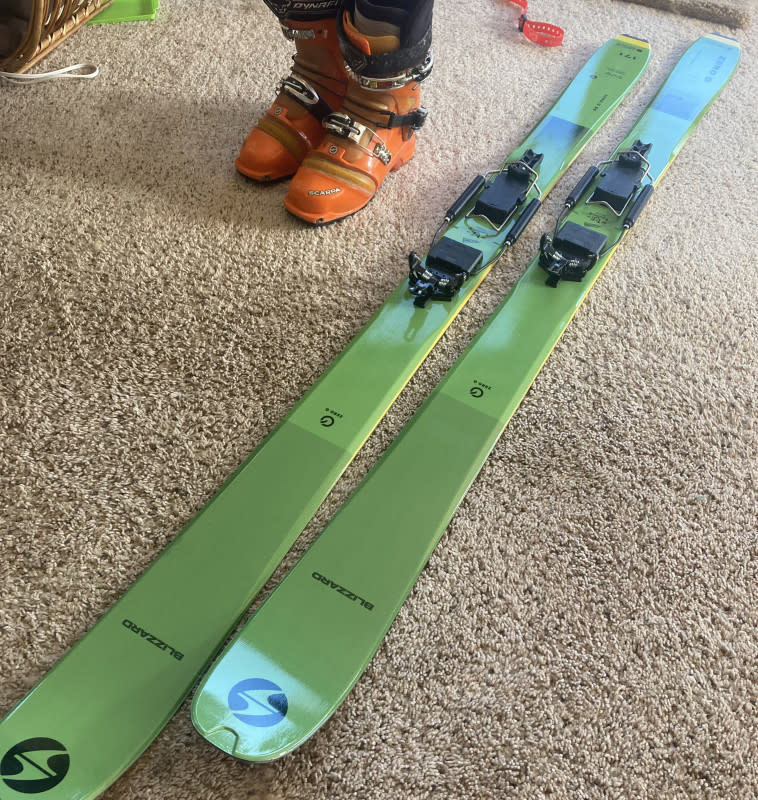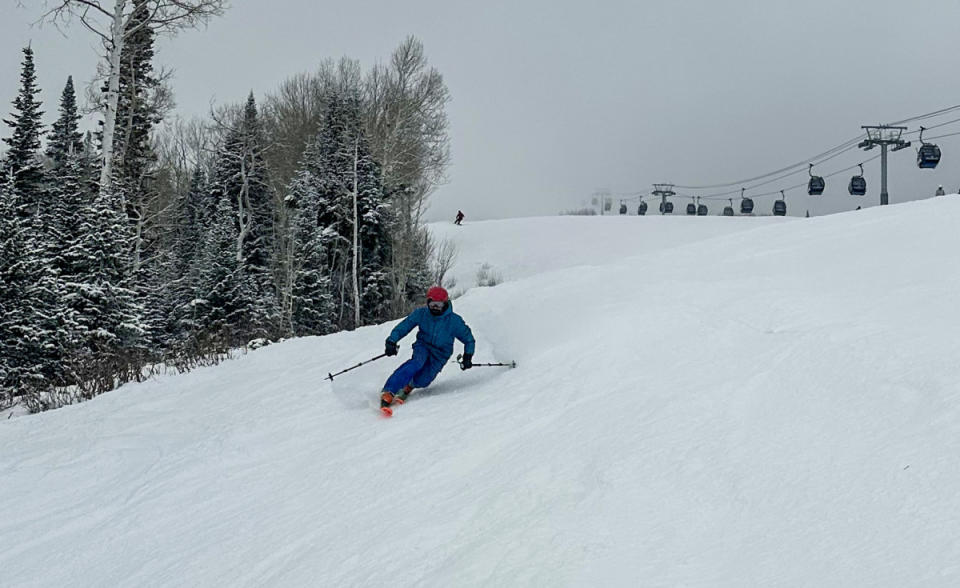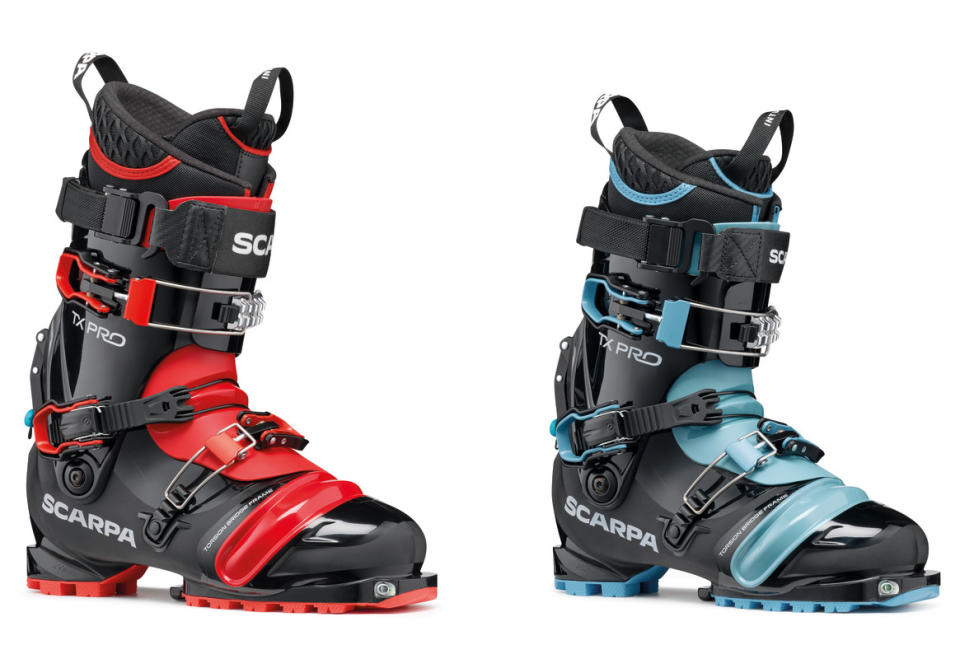On The Snow with the Voile Transit TTS
Powder aims to feature only the best products and services. If you buy something via one of our links, we may earn a commission.
(Title Image)
Telemark once stood as the preferred method of backcountry skiing in North America. But the ascension of light, efficient alpine touring equipment long ago turned that notion upside down. As the skiing masses jumped ship over the years, the telemark turn and its gear became fodder for head-scratching; derided as woefully heavy and antiquated - not to mention requiring an unnecessary technique - compared to the modern vanguard of AT kits and their fixed-heel manner.
While this thinking may have previously stood up to some critique, a new cadre of innovative telemark bindings has torn down this line of reasoning, giving the backcountry free-heel turn a renewed validity, allowing lovers of the telemark turn gear options that have achieved parity with what alpine tourers have long enjoyed.
And one of those traps is Voile’s 2023 TTS Transit – the first plug-and-play, DIY-less telemark tech system binding.
While the binding’s penchant for touring via tech-toe should indeed turn heads (including an AT defector or two), its customizable feel on the descent is also poised to satisfy, allaying many a 75mm holdouts’ misgivings about modern, rigid bindings, while still allowing the lovers of stiff tele turns to have their day, too.

The recently available Transit helps usher in a new retail paradigm for telemark - especially considering new-boot whispers from Scarpa. And the uncomplicated binding skis marvelously.
A telemark tech system (TTS) binding is the marriage of modern functionality with classic free-heel feel: the norm pairs a Dynafit-style tech toe with a cable / cartridge heel assembly commonly associated with 75mm bindings. The Transit from Voile brings Mark Lengel’s 2011 advent into full retail maturity. Previous options on the norm came with a decidedly DIY-heavy nature, while Voile’s iteration (this their mature, second crack at a TTS) thrusts the platform into a new availability and accessibility not seen before.
While the Transit TTS joins the ranks of modern telemark-tech-toe bindings like InWild’s Meidjo and 22 Designs’ Lynx (both NTN-tech options), a contemporary, retail-available boot remains elusive and is still needed to bring telemark fully into modernity. But the long-sought new telemark boot from Scarpa - some ten years in the making - promises to be released next fall, changing the scope of retail options in telemark equipment.
Voile turned to eminent binding manufacturer Plum for the Transit’s toe piece. The tech arms give a snappy and easy entry, and the toe’s metal construction is stout and sleek. The heel assembly is classic Voile – sturdy metal rod fabrication complete with a redesigned heel throw that snugly stays attached to NTN-style boots at the heel shelf in the absence of a heel groove.
The binding comes in small and large sizes, accommodating a range of boot sole lengths at the three different wire positions / pivot points the system offers. The boot matrix on Voile’s sizing guide is comprehensive, and includes Scarpa, Scott, and Crispi boot sole lengths. The large size includes a heel assembly with long travel cartridges to avoid bottoming out the spring, while the small option comes standard with a regular length cartridge. For touring, the assembly can be stowed under the low heel riser or removed and thrown in a pack (shedding 264 grams per binding) though if stowed the lower climbing bar is rendered unusable for touring as it holds the heel assembly in place, though this is the slightest of hindrances.
What’s immediately evident when ascending using the Transit is the efficient touring. The difference is striking coming from 75mm touring bindings. Though the old platform does include free-pivoting options, the free-range movement of a two-pin setup is unmatched in any legacy telemark touring binding, where each stride necessitates raising the entire heel assembly, something the TTS does not require. This new stable of modern tele bindings brings the touring capability inherent in a Dynafit system to telemark, and has elevated the tech toe to gear of choice for backcountry free-heel skiing. And a decade-plus of experimenting on tech toes proves the attachment works for telemark turns.
Furthermore, the 1100 grams per pair is a godsend for telemark tourers who until recently have typically ascended on gear exceptionally heavy compared to alpine touring equipment, save for the aforementioned NTN-tech bindings Meidjo and Lynx. Telemark’s mini-industry, which unavoidably competes with alpine for users and their dollars, also swoons for more options at this weight – something that could help alleviate the gear-driven user-drain telemark has long grappled with.
While the weight of the Transit isn’t comparable to skimo standards (and doesn’t quite approach the likes of a Salomon Shift even at 885 grams) the gap has closed tremendously between available telemark gear - long marked by a heavy-resort paradigm - and the current crop of feather-light alpine touring gear. At least enough to where the justification of leaving telemark for the light weight of AT is not quite as easily to lean on
And while the Transit is an adept touring setup, the system also skis remarkably. Paired with Scarpa F3s – the orange, bellowed AT boots released circa 2008 – the system threads a beautiful weight needle while giving inspired downhill capability (the F3 is often compared to a Scarpa T2 in flex, and some conjecture may have been designed based on the T2 scaffo). Heavier, stiffer (and retail-available) boots can certainly be used with the Transit, though may necessitate a more active setting to break the bellows of the boot in a turn. Still, the binding - both on ascent and descent - shines when paired with a lighter, softer boot.

On the most neutral setting, the turns are not unlike the sweet 75mm flex many telemark skiers are used to; deep-lunging turns are possible, but with an edging efficiency that no duckbill system can quite match. Edge engagement is nearly slopless thanks to transmission through the pin arms instead of through the plastic of a 75mm duckbill, then metal toe cage, and finally to the ski and edge. With that the Transit offers a nearly unmatched confidence on edge, with inspiring hold on the firmest snow, something converts from 75mm will undoubtedly notice and enjoy.
As mentioned, the Transit offers three different wire positions on the binding – the foremost giving the most neutral feel; the aft attachment creating a more resistive engagement. While the forward position gives a sensation similar (but not identical) to the feel of many 75mm bindings, moving the heel assembly back grants the user a more active setup, comparable to modern NTN bindings and their immediate, firm engagement, nudging the skier toward a more compact and upright stance. Regardless, a sensation exists on the TTS Transit for both the lovers of stiff, active bindings and neutral-loving free-heelers - especially when using the softer backcountry cartridge options, which will be available this spring in both standard and long-travel options.
Beyond this, the TTS Transit can be paired with Voile’s proprietary crampon attachment and points. While the binding is mostly hassle-free, the crampon attachment zone - and adjacent mounting screws - can collect snow in heavy and warm conditions. Applying anti-ice tape to this area can help alleviate the problem and the associated boot-jack that can come with. The binding also comes standard with two heel risers at 55mm and 75mm, a mount riser of 17mm, and a toe mount pattern of 30 X 26.5, W x L, in millimeters.

Alas, for those wishing for a truly touring oriented telemark experience, the footwear best paired with a TTS binding remains models long out of production - like the Scarpa Tx, an early, three-buckle NTN boot, mid-2000s vintage Scarpa F1s, and the aforementioned F3s – the latter two both legacy alpine touring boots with a bellows not intended necessarily for telemark, but for ergonomics in the stride on tours.
But whispers from the ISPO trade show in November and Instagram plugs in February have finally given the telemark faithful what they have been pining after for nearly a decade – Scarpa will finally release their new telemark boot – a vastly revamped TX Pro – in the fall of 2024.
And the boot promises to bridge the weight divide in telemark footwear offerings, also long a realm of heavier options, finally bringing to retail a choice that dovetails with lighter touring bindings like the Transit TTS.
“We did see this opportunity with this lightweight boot,” Mark Christopherson, production manager and partner at Voile says. Voile long had eyes on Scarpa’s new telemark boot program, with Christopherson testing prototypes and regularly communicating with the manufacturer. “We really encouraged them,” Christopherson continued, “I really thought that would be something that people were looking for. And after all these years, I think now that [word on the new boot is] out there, people are really happy that it is going to be coming. And it will be a good choice for those that want to do more backcountry skiing.”
The boot is poised to be the lightest on the telemark market (with the size 27 claiming a weight of 1545 grams), improved range of motion for touring, as well as NTN compatibility. Soon the TTS Transit can be paired with the most modern telemark boot the sport has seen in years, with features designed for a touring-oriented system and will be available at retail.
While some of the chatter from the telemark throngs on social media shows muted conviction for the boot and its one-size-fits all singularity, the pending release – and its potential pairing with bindings like the TTS Transit – nevertheless helps bring telemark into a modern paradigm, and one that can finally be realized in mainstream ski shops, not just in the cutting edge, but far from turnkey world of free-heel DIY garage laboratories (long may they live!).

The Voile TTS Transit is a revelation, and not only as a touring binding. While options allow it to come as close as possible to preserving the telemark sensation that many old-gear holdouts love, it can also be customized to the feel of more rigid, modern bindings, too. Maybe nothing can quite replace the sweet flex of duckbill boots and 75mm bindings, but the Transit comes ever so close while also bringing a touring efficiency, downhill power transmission, and customization of feel that the duckbill just can’t compete with.
And Scarpa’s new Tx Pro promises to bring the Transit’s capabilities to full retail fruition - a pairing that, together with the stable of other modern free-heel bindings, could move telemark toward a renewed modern standard and sales facing. Still, there’s yet to be any indication (outside of whispered rumors) that Scarpa will release a lighter, lower boot in their modern telemark line, or for that matter a burley resort-oriented option with similar specs. But if the new Tx Pro sees enough traction, perhaps the singular boot can become a line of footwear.
A new dawn in telemark gear - long in the making - will soon be more fully realized, one where the gear has broader parity with alpine, finally abating the flow of participants to AT who fled to the other side for the sake of weight and touring efficiency. Voile’s TTS Transit is just more proof that telemark is back with touring gear par excellence - and is poised for the future.

